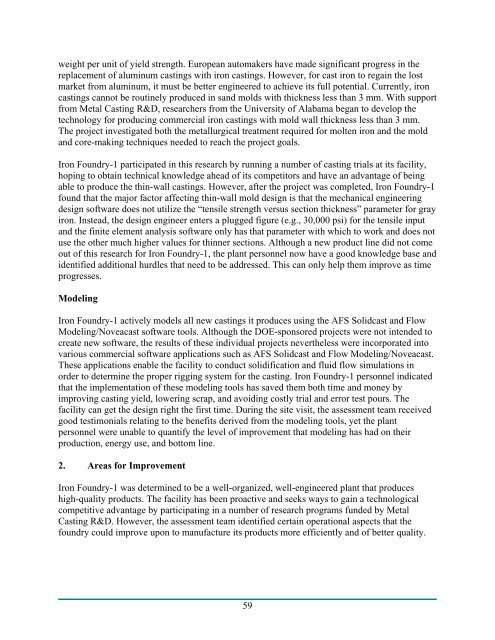Implementation of Metal Casting Best Practices - EERE - U.S. ...
Implementation of Metal Casting Best Practices - EERE - U.S. ...
Implementation of Metal Casting Best Practices - EERE - U.S. ...
Create successful ePaper yourself
Turn your PDF publications into a flip-book with our unique Google optimized e-Paper software.
weight per unit <strong>of</strong> yield strength. European automakers have made significant progress in the<br />
replacement <strong>of</strong> aluminum castings with iron castings. However, for cast iron to regain the lost<br />
market from aluminum, it must be better engineered to achieve its full potential. Currently, iron<br />
castings cannot be routinely produced in sand molds with thickness less than 3 mm. With support<br />
from <strong>Metal</strong> <strong>Casting</strong> R&D, researchers from the University <strong>of</strong> Alabama began to develop the<br />
technology for producing commercial iron castings with mold wall thickness less than 3 mm.<br />
The project investigated both the metallurgical treatment required for molten iron and the mold<br />
and core-making techniques needed to reach the project goals.<br />
Iron Foundry-1 participated in this research by running a number <strong>of</strong> casting trials at its facility,<br />
hoping to obtain technical knowledge ahead <strong>of</strong> its competitors and have an advantage <strong>of</strong> being<br />
able to produce the thin-wall castings. However, after the project was completed, Iron Foundry-1<br />
found that the major factor affecting thin-wall mold design is that the mechanical engineering<br />
design s<strong>of</strong>tware does not utilize the “tensile strength versus section thickness” parameter for gray<br />
iron. Instead, the design engineer enters a plugged figure (e.g., 30,000 psi) for the tensile input<br />
and the finite element analysis s<strong>of</strong>tware only has that parameter with which to work and does not<br />
use the other much higher values for thinner sections. Although a new product line did not come<br />
out <strong>of</strong> this research for Iron Foundry-1, the plant personnel now have a good knowledge base and<br />
identified additional hurdles that need to be addressed. This can only help them improve as time<br />
progresses.<br />
Modeling<br />
Iron Foundry-1 actively models all new castings it produces using the AFS Solidcast and Flow<br />
Modeling/Noveacast s<strong>of</strong>tware tools. Although the DOE-sponsored projects were not intended to<br />
create new s<strong>of</strong>tware, the results <strong>of</strong> these individual projects nevertheless were incorporated into<br />
various commercial s<strong>of</strong>tware applications such as AFS Solidcast and Flow Modeling/Noveacast.<br />
These applications enable the facility to conduct solidification and fluid flow simulations in<br />
order to determine the proper rigging system for the casting. Iron Foundry-1 personnel indicated<br />
that the implementation <strong>of</strong> these modeling tools has saved them both time and money by<br />
improving casting yield, lowering scrap, and avoiding costly trial and error test pours. The<br />
facility can get the design right the first time. During the site visit, the assessment team received<br />
good testimonials relating to the benefits derived from the modeling tools, yet the plant<br />
personnel were unable to quantify the level <strong>of</strong> improvement that modeling has had on their<br />
production, energy use, and bottom line.<br />
2. Areas for Improvement<br />
Iron Foundry-1 was determined to be a well-organized, well-engineered plant that produces<br />
high-quality products. The facility has been proactive and seeks ways to gain a technological<br />
competitive advantage by participating in a number <strong>of</strong> research programs funded by <strong>Metal</strong><br />
<strong>Casting</strong> R&D. However, the assessment team identified certain operational aspects that the<br />
foundry could improve upon to manufacture its products more efficiently and <strong>of</strong> better quality.<br />
59

















